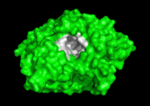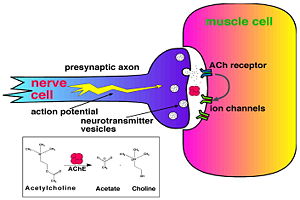Acetylcholinesterase
From Proteopedia
| Line 7: | Line 7: | ||
[[Image:Synapse_Schematic.jpg|thumb|Cholinergic Synapse|300px|left]] | [[Image:Synapse_Schematic.jpg|thumb|Cholinergic Synapse|300px|left]] | ||
| - | + | The 3D structure of ''Torpedo californica'' AChE (''Tc''AChE) ([http://www.ncbi.nlm.nih.gov/sites/entrez?cmd=Retrieve&db=PubMed&dopt=Citation&list_uids=1678899 Sussman et al. & Silman (1991)]) opened up new horizons in research on an enzyme that had already been the subject of intensive investigation. The unanticipated structure of this extremely rapid enzyme, in which the active site was found to be buried at the bottom of a | |
| - | + | ||
| - | rapid enzyme, in which the active site was found to be buried at the bottom of a | + | |
<scene name='Acetylcholinesterase/New_down_active_site_gorge/2'>deep and narrow gorge</scene>, | <scene name='Acetylcholinesterase/New_down_active_site_gorge/2'>deep and narrow gorge</scene>, | ||
| - | lined by aromatic residues, led to a revision of the | + | lined by aromatic residues, led to a revision of the views then held concerning substrate traffic, recognition, |
| - | views then held concerning substrate traffic, recognition, | + | and hydrolysis ([http://www.ncbi.nlm.nih.gov/sites/entrez?cmd=Retrieve&db=PubMed&dopt=Citation&list_uids=10545346 Botti et al. Sussman & Silman (1999)]). |
| - | and hydrolysis ([http://www.ncbi.nlm.nih.gov/sites/entrez?cmd=Retrieve&db=PubMed&dopt=Citation&list_uids=10545346 Botti et al. Sussman & Silman (1999)]) | + | |
| - | + | ||
| - | + | ||
| - | + | ||
| - | + | ||
| - | + | ||
| - | + | ||
| - | Alzheimer’s disease (AD) is a debilitating brain disease that occurs in around 10% of the elderly and, as yet, there is no known cure. At present, the most widely used treatments consist are medications that | + | Alzheimer’s disease (AD) is a debilitating brain disease that occurs in around 10% of the elderly and, as yet, there is no known cure. At present, the most widely used treatments consist are medications that attempt to increase the brain’s levels of ACh, whose levels decrease with onset of disease. These drugs work by interfering with AChE. Thus drugs that are mild inhibitors of AChE, like Tacrine, E2020 (Aricept) and the Traditonal Chinese Medicine (TCM) Huperzine appear to retard symptoms of AD. |
| - | attempt to increase the brain’s levels of ACh, whose levels decrease with onset of disease. These drugs | + | |
| - | work by interfering with AChE. | + | |
| - | Thus drugs that are mild inhibitors of AChE, like Tacrine, E2020 (Aricept) and the | + | |
| - | <applet load='1ea5_rot.pdb' size='300' color='white' frame='true' spin='on' caption='AChE' align='right' script='Acetylcholinesterase/ | + | <applet load='1ea5_rot.pdb' size='300' color='white' frame='true' spin='on' caption='AChE' align='right' script='Acetylcholinesterase/Ache_gorge/1' |
'''3D structure of acetylcholinesterase'''<br /> | '''3D structure of acetylcholinesterase'''<br /> | ||
| - | The active site region of this enzyme has two sites, a catalytic site and a peripheral site, which helps prebind the substrate and direct it toward the active site. When the | + | The active site region of this enzyme has two sites, a catalytic site and a peripheral site, which helps prebind the substrate and direct it toward the active site. When the 3D structure was first determined, the big surprise was that the active site was deep inside the protein, at the end or base of a <scene name='Acetylcholinesterase/Ache_gorge/1'>deep and narrow gorge </scene>, lined with aromatic residues, with the peripheral site at the top or lip of this gorge. Amazingly, there were no acidic or negatively charged |
residues anywhere in these 2 sites or along this gorge, as would be expected to | residues anywhere in these 2 sites or along this gorge, as would be expected to | ||
help attract and bind the basic, positively charged ACh substrate, although are are some acidic residues nearby. Instead, bulky aromatic residues <scene name='Acetylcholinesterase/1ea5_279_84/2'>Trp 279 and Tyr 121 dominate the peripheral site, and Trp 84 and Phe 330 the active site, together with His 440. </scene> (These numbers are the sequential numbering | help attract and bind the basic, positively charged ACh substrate, although are are some acidic residues nearby. Instead, bulky aromatic residues <scene name='Acetylcholinesterase/1ea5_279_84/2'>Trp 279 and Tyr 121 dominate the peripheral site, and Trp 84 and Phe 330 the active site, together with His 440. </scene> (These numbers are the sequential numbering | ||
Revision as of 15:26, 22 January 2008
|
Key Enzyme in the Nervous System
Acetylcholinesterase (AChE) is key enzyme in the nervous system of animals. By rapid hydrolysis of the neurotransmitter, acetylcholine (ACh), AChE terminates neurotransmission at cholinergic synapses. It is a very fast enzyme, especially for a serine hydrolase, functioning at a rate approaching that of a diffusion-controlled reaction. AChE inhibitors are among the key drugs approved by the FDA for management of Alzheimer's disease (AD). The powerful toxicity of organophosphorus (OP) poisons is attributed primarily to their potent AChE inhibitors.
The 3D structure of Torpedo californica AChE (TcAChE) (Sussman et al. & Silman (1991)) opened up new horizons in research on an enzyme that had already been the subject of intensive investigation. The unanticipated structure of this extremely rapid enzyme, in which the active site was found to be buried at the bottom of a , lined by aromatic residues, led to a revision of the views then held concerning substrate traffic, recognition, and hydrolysis (Botti et al. Sussman & Silman (1999)).
Alzheimer’s disease (AD) is a debilitating brain disease that occurs in around 10% of the elderly and, as yet, there is no known cure. At present, the most widely used treatments consist are medications that attempt to increase the brain’s levels of ACh, whose levels decrease with onset of disease. These drugs work by interfering with AChE. Thus drugs that are mild inhibitors of AChE, like Tacrine, E2020 (Aricept) and the Traditonal Chinese Medicine (TCM) Huperzine appear to retard symptoms of AD.
|
The active site region of this enzyme has two sites, a catalytic site and a peripheral site, which helps prebind the substrate and direct it toward the active site. When the 3D structure was first determined, the big surprise was that the active site was deep inside the protein, at the end or base of a , lined with aromatic residues, with the peripheral site at the top or lip of this gorge. Amazingly, there were no acidic or negatively charged residues anywhere in these 2 sites or along this gorge, as would be expected to help attract and bind the basic, positively charged ACh substrate, although are are some acidic residues nearby. Instead, bulky aromatic residues (These numbers are the sequential numbering of the residues, starting from the N-terminus, according to the Torpedo Californica form of the enzyme.) See: AChE inhibitors and substrates
Selected 3D Structures of AChE
- 2ace This is the original solved structure for Torpedo Californica
- 1ea5 This is one of the highest quality representative X-ray structures in the PDB.
- 1eve The E2020 (Aricept) complex.
- 1ax9 Endrophonium complex.
- 1vot Complex with Huperzine, a Chinese folk medicine.
- 1fss Complex with snake venum toxin Fasciculin-II.
- 1vzj Model complex of the Cholinesterase tetramer.
More structures can be obtained by searching for 'AChE' at the left.
Proteopedia Page Contributors and Editors (what is this?)
Michal Harel, Joel L. Sussman, Alexander Berchansky, David Canner, Eran Hodis, Clifford Felder, Jaime Prilusky, Harry Greenblatt, Yechun Xu


